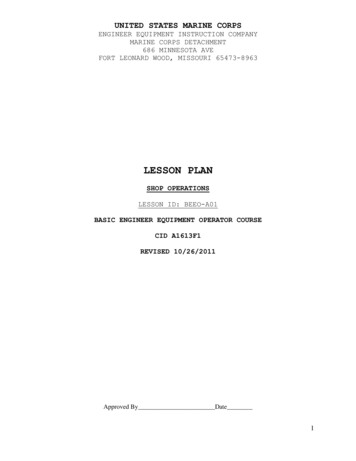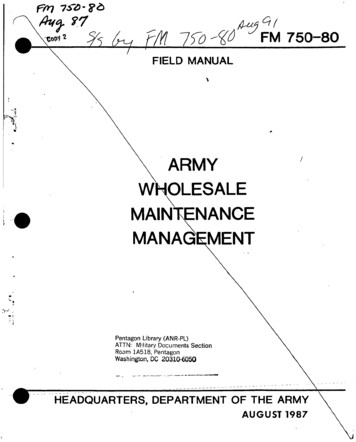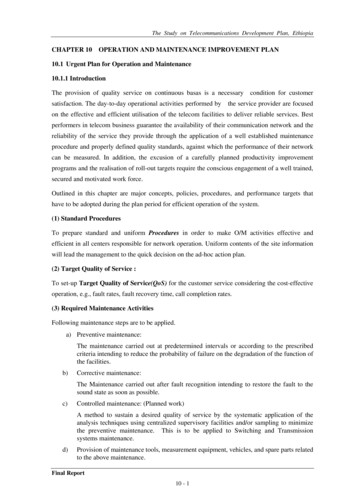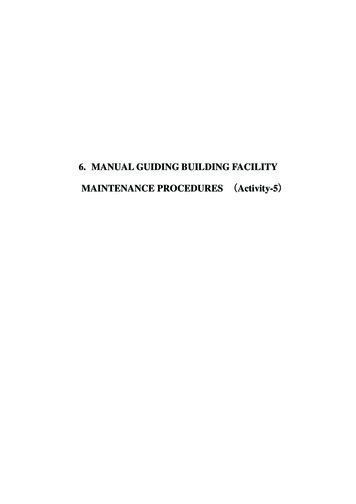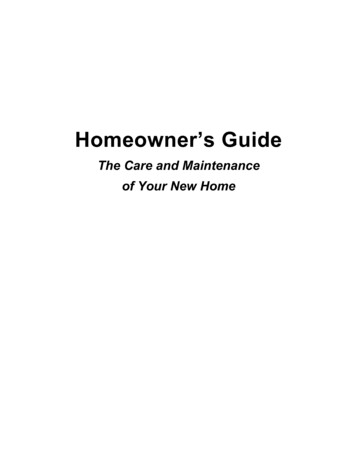
Transcription
Homeowner’s GuideThe Care and Maintenanceof Your New Home
TABLE OF CONTENTSWelcomeI.Warranty StatementExclusions from Warranty CoverageMaintenance Schedule60-Day Warranty Service Request11-Month Warranty Service RequestII.Lot, Landscaping and ConcreteLotLandscapingConcreteIII.Home Care and MaintenanceExterior Materials and FinishMasonry and RoofLumber and MillworkInterior Walls and CeilingsFloor CoveringCentral Heat and AirPlumbing and ElectricalAppliancesIV.Home Care and MaintenanceV.SafetyVI.Homeowner TipsGehan Homes’ Homeowner’s Guide - The Care and Maintenance of Your New HomeMay 2020
Welcome Home!Congratulations on the purchase of your new home and welcome to our family of homeowners! We trustthat the pride we have taken in crafting your home will be evident today and for years to come.Practical tips, maintenance checklists and solutions to common issues can be found in the Home Careand Maintenance section of this Guide. The information in this section will help you take a proactiveapproach to upkeep and maintenance, as well as provide you with invaluable tips to protect yourinvestment and keep your home in top condition.While great care was taken in the construction of your new home, occasionally problems occur GehanHomes has provided you with a Limited Warranty to address these eventualities. This Homeowner’sGuide provides you with details about how to obtain service covered by your Limited Warranty along withother helpful information related to homeownership.Information about your Limited Warranty was included in your closing paperwork. We encourage you tofamiliarize yourself with the details of your Limited Warranty. Rest assured that we will continue to provideyou with exceptional service long after you have moved into your new home. We are available to answeryour questions and will make every effort to ensure your experience with Gehan Homes is a positive one.As you turn your new house into a warm and welcoming home that reflects your personal style, know thatGehan Homes stands with you. Whether this is your first new home or you are a seasoned homeowner,we are committed to enhancing your ownership experience and building a long-lasting and mutuallyrewarding relationship.Gehan Homes’ Homeowner’s Guide - The Care and Maintenance of Your New HomeMay 2020
I.WARRANTY STATEMENTGehan Homes warrants against defects caused by faulty workmanship and materials due to noncompliance with approved construction standards set forth by our warranty company during year one only.To prevent misunderstandings, you should become familiar with these approved standards by reading theInsurance/Warranty Documents provided by the warranty company.Gehan Homes’ warranty program meets industry standards and it is a limited warranty. Many itemsare excluded from warranty coverage for various reasons. Several of these excluded items were notedduring your walk-throughs. Others are listed in this sectionIt is of great benefit for homeowners to have an appreciation and understanding of homeconstruction and care. Certain conditions and changes are inevitable or unavoidable due to time,atmospheric or ground conditions, etc. and require care by the homeowner.Gehan Homes reserves the right to decide whether to repair or replace damaged materials.The wide range of materials used in your new home are subject to some degree of wear throughhandling and installation. Minor scratches, dents, or other imperfections in wood trim, sliding glass doors,countertops, doors, wallpaper, glass surfaces and other areas will occur and are unavoidable. Minorvariations in wood finishes, caused by natural variation in the wood grain, will also occur. Should they beof a magnitude to be readily and immediately apparent, Gehan Homes will correct them; however, minorand hard-to-see nicks, scratches, cuts, blemishes and finish variations are not covered by Gehan Homes’warranty.Exclusions from Warranty CoverageAppliances/Equipment: Your warranties on appliances, equipment and other consumer productsare provided by the manufacturer. The warranty information pertaining to these items is enclosed in yourhomeowner package.Driveways, Sidewalks, Patios and Other Flatwork: These are poured separately from yourhouse slab and are subject to slight movement that will cause hairline cracks. These cracks are of commonoccurrence due to soil conditions and are not covered by your Limited Warranty.Landscaping/Sod: As noted during your walk-through, your sod and landscaping (if applicable) isalive and in good condition. Landscaping and sod require immediate attention upon move-in and are yourresponsibility. Your warranty does not cover sod and landscaping that dies due to a lack of water (which iscritical in winter months too), a lack of fertilizer, the effects of temperature, neglect, insect infestation orabuse.Grading and Drainage: Gehan Homes is responsible for initially establishing the proper gradesand swales to ensure proper drainage away from the home. You are responsible for maintaining thesegrades and swales. Ground cover should be established immediately over exposed areas of the yard toprevent wash-outs and erosion from intense rainfall. Your Limited Warranty does not apply to gullies,erosion, or water standing or ponding in your yard which lasts for less than 24 hours.Fixtures: These include plumbing and electrical fixtures and interior and exterior locks. Thesefixtures tarnish naturally and their appearance is not warranted.Cracks: These include drywall, molding, tile grout, mortar, concrete and wood cracks. Hairlinecracks are common in these materials due to shrinkage and settling and are not covered in your LimitedWarranty.Gehan Homes’ Homeowner’s Guide - The Care and Maintenance of Your New HomeMay 2020
Fiberglass Doors: These doors require re-staining and re-application of urethane after exposureto sunlight for prolonged periods. The need for re-staining and the re-application of urethane to these doorsis not covered under your Limited Warranty.Wrinkling Roof: Roof rafters will be apparent under shingles depending upon the angle of the sunand time-of-year. This is common and no effort will be made to correct it.Vinyl: Vinyl is a soft material that dents, scratches, tears and pits easily. Therefore, vinyl is notcovered in your warranty.Loss or Damage Caused By or Resulting from Acts of God: Examples of damage caused byActs of God include freeze damage to pipes, insect infestation of sod or landscaping and wind-driven waterentering the home through brick, vents, windows or doors. Acts of God are neither predictable nor avoidableand damage/loss due to Acts of God are not covered under your Limited Warranty.Garage Door Openers Not Installed By Gehan Homes: Any changes to the garage door,including the installation of a garage door opener by other than Gehan Homes, without written approvalfrom Gehan Homes, will void any warranty on the door itself.Water Heater: Because of the location of the water heater and the various acceptable means ofrunning water lines used by plumbing contractors, Gehan Homes cannot guarantee the lead time for hotwater to reach fixtures. Our maximum allowable lead time will be 2 minutes.Gehan Homes’ Homeowner’s Guide - The Care and Maintenance of Your New HomeMay 2020
II.MAINTENANCE SCHEDULEItemMonthlyClean and test smoke alarmsxTest and reset all GFIsxClean and change A/C filterxQuarterlySemi-annuallyAnnuallyOr as directed by manufacturerInspect HVAC systemxInspect site drainagexSeal exterior masonry cracksxInspect exterior paint or stainxTouch up caulk and groutxDrain water from bottom of waterheaterxClean guttersxClean window weep holesxClean masonry weep holesxInspect roof and chimney flashingsxxInspect hoses for washingmachinexxInspect secondary pan underHVAC unitxClean chimneyInspect exterior for birds’ nestsand remove (bird droppings are asource of mold in an attic space)Inspect for visible moldReplace every 5 yearsxInspect water heater panInspect caulking around windowsand doorsOr as directed by manufacturerxOperate pressure relief valve onwater heaterInspect under dishwasher forleaksSeasonallyxLubricate garage overhead doorand tighten boltsInspect behind refrigerator,icemaker and washing machinefor leaksCommentsxxOr as neededxxGehan Homes’ Homeowner’s Guide - The Care and Maintenance of Your New HomeMay 2020
60-DAY WARRANTY SERVICE REQUESTCONTACT INFOAddress:Name 1:Name 2:Home Number:Home Number:Cell Number:Cell Number:Email:Email:NOTE TO HOMEOWNER(S):IT IS REQUIRED THAT YOU, OR YOUR REPRESENTATIVE OVER THE AGE OF 18, BE PRESENT IN THE HOME WHILE ALLSERVICE WORK IS BEING PERFORMED. ENTRY TO THE HOME MUST BE PROVIDED DURING NORMAL WORKING HOURSFROM 8:00 A.M. TO 5:00 P.M., MONDAY THRU FRIDAY. YOU ARE RESPONSIBLE FOR SUBMITTING THIS TO THE WARRANTYDEPARTMENT. DO NOT PRESENT TO SALES PERSONNEL OR BUILDERS.Item #DescriptionFor CO. UseOtherI HAVE REVIEWED THE ABOVE REPAIRS AND FIND EACH WARRANTABLE ITEM HASBEEN REPAIRED IN A GOOD AND WORKMANLIKE MANNER AND I UNDERSTAND THATTHESE REPAIRS DO NOT EXTEND THE LIFE OF THE GEHAN HOMES’ LIMITEDWARRANTY.CompleteOffice Use OnlyPAINT COLORS(Please do not sign until warrantable work has been completed)AccentHomeowner SignatureDateBaseShuttersService Technician SignatureDateDoorsTo request warranty service, call us at 877.434.2689, email us at warranty@gehanhomes.com or use the online request form on our website athttp://www.gehanhomes.comGehan Homes’ Homeowner’s Guide - The Care and Maintenance of Your New HomeMay 2020
11-MONTH WARRANTY SERVICE REQUESTCONTACT INFOAddress:Name 1:Name 2:Home Number:Home Number:Cell Number:Cell Number:Email:Email:NOTE TO HOMEOWNER(S):IT IS REQUIRED THAT YOU, OR YOUR REPRESENTATIVE OVER THE AGE OF 18, BE PRESENT IN THE HOME WHILE ALL SERVICEWORK IS BEING PERFORMED. ENTRY TO THE HOME MUST BE PROVIDED DURING NORMAL WORKING HOURS FROM 8:00 A.M.TO 5:00 P.M., MONDAY THRU FRIDAY. YOU ARE RESPONSIBLE FOR SUBMITTING THIS TO THE WARRANTY DEPARTMENT. DONOT PRESENT TO SALES PERSONNEL OR BUILDERS.Item #DescriptionFor CO. UseOtherCompleteI HAVE REVIEWED THE ABOVE REPAIRS AND FIND EACH WARRANTABLE ITEM HAS BEENREPAIRED IN A GOOD AND WORKMANLIKE MANNER AND I UNDERSTAND THAT THESEREPAIRS DO NOT EXTEND THE LIFE OF THE GEHAN HOMES’ LIMITED WARRANTY.Office Use Only(Please do not sign until warrantable work has been completed)PAINT COLORSHomeowner SignatureDateAccentBaseService Technician SignatureDateShuttersDoorsTo request warranty service, call us at 877.434.2689, email us at warranty@gehanhomes.com or use the online request form on ourwebsite at www.gehanhomes.comGehan Homes’ Homeowner’s Guide - The Care and Maintenance of Your New HomeMay 2020
III.LOT, LANDSCAPING AND CONCRETELotBoundaries and EasementsYour lot was surveyed by a licensed surveyor after your home was built. A copy of the survey wasgiven to you by the title company at closing. The survey shows your lot size and the location of lotboundaries and drainage.The survey will also show by dotted or broken lines if there are any easements affecting yourproperty. The most common type of easement is the “utility easement,” usually located parallel with the rearor side lot lines.The homeowners retain title to the property, subject to the rights of persons or firms to whom theeasement has been granted. You are responsible for the maintenance of an easement. Since the utilitycompanies are permitted access across utility easements at any time, an easement must never beobstructed so as to prevent such access. Your title company can answer any questions you have regardingyour rights or responsibilities relating to an easement.The engineers drove in iron lot pins at each corner of your lot when they made your lot survey.Their location is shown on the survey with the letters “IP”. Be sure to check your survey and locate your lotpins anytime you plan additional construction, such as a fence. The tops of the lot pins will be below thesurface of the finished lot grading. If you are not able to locate them yourself, the firm noted on the surveymay locate them for a minimum service charge.Grading and DrainageThe primary purpose of finished lot grading is to provide drainage away from the foundation of yourhome. This grading is done in compliance with the standards established by our engineers, the FHA, theVA and municipal governments. Your survey states that Gehan Homes is responsible only for initiallyestablishing the proper grades and swales. You are responsible for maintaining such grades and swales,which may/will be altered by the rain.Soil has qualities that lead to expansion and contraction when moisture is introduced or removed.IT IS IMPORTANT THAT WATER NOT BE ALLOWED TO STAND NEAR A HOUSE FOUNDATION. Toaffect proper drainage away from the building, it is often necessary to create a drainage swale (an openchannel) to carry off surface water. Frequently, such swales not only carry the drainage from your property,but also intercept and carry drainage from higher, adjacent properties. Extreme care should be exercisedto ensure that the drainage pattern is not altered, as severe damage to the foundation and structure of yourhome may result from doing so. Blocking or altering the flow of water across your lot may damage not onlyyour home, but may also damage a neighbor’s property as a result of the modification of the drainage plan.Because drainage swales serve such an important function, it is essential that you keep themunaltered and free from blockage. An early effort to get a good stand of grass in the swales will be aworthwhile investment in minimizing drainage problems.SoilBecause soil erosion cannot be prevented by Gehan Homes, it is excluded from warranty coverage.Since loose soil may wash onto walks, drives and streets, or fill the drainage swales before getting acomplete cover of grass, it is important that you keep eroded soil removed from these areas during theperiod of time between move-in and establishing grass coverage. This can be accomplished with a handrake.Gehan Homes’ Homeowner’s Guide - The Care and Maintenance of Your New HomeMay 2020
Some soil contains a type of clay that is very sensitive to water conditions. When expanded withheavy moisture, these soils can exert tremendous pressure on concrete foundations and other structuresin the soil. These pressures can force expansion both upwards and sideways.The greatest expansion occurs when totally dry soil suddenly becomes saturated, so soil engineersstrongly recommend light watering at regular intervals in areas around foundations and other structures.Such watering will prevent severe contraction and expansion of the soil.Take care to see that no depressions in the soil close to the foundation can collect and hold waterand that drainage away from the foundation and other concrete structures is definite, yet gradual.Gehan Homes suggests shrubs be planted at least two feet from the foundation and be wateredregularly so the roots will not draw excessive amounts of water from the soil under the slab.When you are watering, take care not to run sprinklers on the soil right at your foundation or on thewalls of the structure for long periods. The brick mortar and woodwork making up the exterior of your homecan transfer moisture from the outer to the inner walls if water is run against it long enough. Also, the exteriorwood of your home will expand if kept wet over long periods and then be subjected to drying and shrinkagewhen the watering is stopped.LandscapingTreesNon-native trees should be planted at least ten feet from the house. Care should be taken inpreparing the ground for tree or shrub planting to avoid damaging water, sewer or electric lines with a pickor a shovel. If you are in doubt about the location of buried lines or cables, call the appropriate utilitycompany and it will locate and mark the lines for you. If you have native trees on your lot, avoid fertilizingor watering them excessively – they are not conditioned to it.Watering of newly planted trees must be done in a deep soaking fashion. A slow drip or wateringfrom a hose is required. Sprinkler systems provide only a topical watering for trees. Many new trees requirethis deep soaking at least three times a week.SodIf applicable, we have installed a durable, low maintenance grass lawn in the front of your home.The following information will assist you in properly caring for your lawn.Immediately after installation, water all sodded areas until the water has saturated through thebottom of the sod’s dirt pad. This is critical even during the winter months. If water accumulates into puddleson top of the sod prior to its saturation, turn off the sprinkler in that particular area and allow the water tosoak in. Check the sod daily to ensure the dirt pad is still moist. If so, watering may be skipped that day. Ifit is drying out, water the sod again. Reflected heat along buildings and large concrete areas dries sod morequickly, so be sure to check these areas often.Do not be alarmed if your grass turns yellow or brown for the few days after planting. It is notabnormal for the sod to go into shock. Continue the watering procedure until the sod has begun to take rootsecurely into the soil. In growing season, this usually takes five to ten days. In dormant season, it will varydepending on the temperature. After roots take securely to the soil, the watering schedule can be the sameas for an established lawn. Watering should be done once every three days for 15 to 20 minutes. Thefrequency may increase during extremely hot summers, but during spring, winter, and fall months, it will bemore than adequate. Watering during the morning hours will eliminate many types of fungus and moldproblems. Avoid watering after sundown and never water so heavily that run off is apparent.Gehan Homes’ Homeowner’s Guide - The Care and Maintenance of Your New HomeMay 2020
FertilizingA balanced lawn fertilizer should be applied to your new sod after installation. It may be doneimmediately, even before the initial watering. The first fertilization will act as a stimulant to establish yourgrass sooner. Use any of the following fertilizer ratios at a medium application rate: 12-12-12, 13-13-13, 88-8, 10-20-10, 8-10-8, or a similar ratio, depending on your location. After establishment of the lawn, itshould be put on a regular program of fertilization. You may contact a reputable company to apply thisprogram for you. If you desire to maintain your own lawn, it is advisable to consult an arborist or landscapeprofessional for information about the best way to maintain the fertilization of your lawn.ConcreteFoundationConcrete expands in the summer heat and contracts in the winter cold. This unavoidablemovement is further aggravated in some areas by soils that expand when moisture is introduced. Wetweather can cause the ground to expand and may lift the foundation. In most cases, the foundation willraise uniformly causing no damage, hence the term “floating” foundation.Problems occur when there is uneven watering. It is imperative that you water your back yardwhenever you water your front yard to maintain the same conditions in both. Failure to do so may causedifferential settlement – one portion of your house may be lifted while another portion may settle.Foundation MaintenanceProper foundation maintenance will minimize the impact of differential soil movement. Because ofheavy rains, it is impossible to keep moisture away from the foundation. However, good drainage will controlexcessive moisture. Excessive drying of the soil can be prevented by controlled watering around thefoundation during dry seasons. Trees and other large vegetation accelerate the drying process and carefulconsideration should be given when planting so an adequate distance from the foundation can bemaintained. Proper landscaping and ground cover will help prevent drying.Cracks in the soil from drying should not be allowed to form. If they do, gradual watering should beapplied adjacent to the cracks so that they will close. Water should not be placed directly into the opencracks.The objective of a proper foundation maintenance program is to sustain as consistent a moisturecontent as possible in the soil under the foundation and around the perimeter of the house. Monitoring yourwatering program during dry seasons is essential and thought must be given to the effect that trees havein the removal of soil moisture during these dry seasons.Recommended Steps for Foundation Maintenance and Care: Maintain drainage away from the foundation with a suggested slope of four inches in the first sixfeet away from the foundation. Fill any depressions adjacent to or near the foundation with native soil. Do not use pure sand orother granular materials. Use soil of similar consistency as the rest of your soil. Check gutters and downspouts to be sure that water is discharged away from the foundation. Watershould be carried approximately four feet from the slab.Gehan Homes’ Homeowner’s Guide - The Care and Maintenance of Your New HomeMay 2020
Water liberally around the foundation during dry spells. This should be done in a uniform manneraround the entire house to prevent uneven soil moisture. This will include the areas of the yardwhere there is not grass or plants. Automatic lawn sprinkling or automatic foundation soaker hosesystems may be installed and are very beneficial. Even with an automatic watering system, youmust still inspect your yard for even moisture distribution. Plant trees a distance away from the foundation equal to their anticipated height. If existing treesare near the foundation, they will draw water from the foundation, thus requiring more water withinthis area. Sometimes tree roots that go under the foundation will need to be cut and a barrier trenchinstalled to prevent new roots from growing under the foundation.Protecting Walks, Drives, Patios and Garage or Carport Slabs (Flatwork)Soil conditions and climate characteristics described herein make it necessary for you to takeroutine precautions for the protection of your home’s concrete and masonry work.Gehan Homes offers these facts and suggestions:1. Expansion and ContractionWalks, drives, patios and garage or carport slabs are subject to the same effects of soilconditions as your home’s foundation. These surfaces contain less reinforcement than thefoundation, since they support little or no structural weight, but their exposure to extreme heatand cold causes noticeable expansion and contraction.2. Expansion JointsExpansion joints are located in walks and drives at regular intervals to prevent a break in theconcrete when it expands. When the joint absorbs the forces of expansion the joint materialmay be forced or squeezed above the surface of the concrete.3. To Trim or Leave Alone?If the expansion joint material becomes unsightly, you can trim off the protruding edge flushwith the surface of the concrete. However, when the concrete is cold, contraction may reopenthe joint, leaving an opening larger than intended or desired. These openings should not befilled too soon, since the space may be needed when the concrete expands again. Eventually,due to normal settling, the gap may become permanent. Use sand, not dirt, to fill the opening.Your flatwork was built using sound construction methods; however, surface cracking may stilloccur. Surface cracks are normal and are not cause for alarm since they exist merely on the surface, anddo not affect the strength of the concrete. If you wish to repair the surface crack, use a paintbrush to fill wetconcrete into the crack. Remove excess mix from the surface with a damp sponge or cloth.Gehan Homes’ Homeowner’s Guide - The Care and Maintenance of Your New HomeMay 2020
IV.HOME CARE AND MAINTENANCEExterior Materials and FinishThe homes in your neighborhood were built with a wide variety of exterior finish materials chosenfor their aesthetics and easy maintenance characteristics. All such materials are subject to expansion andcontraction, weathering and aging. The finish of some surfaces age faster than others, depending on itsexposure to the elements.The general characteristics of the primary materials used are discussed below.WoodWood generally requires a finishing coat to protect it from the elements. Many of the characteristicsof wood while alive are retained for years after its repurpose as a building material. For example, wood maybleed sap, it may shrink and change shape in some instances and can expand with moisture.Gehan Homes uses care in selecting the type of wood best suited for the performance of a specificfunction. Nevertheless, some of these natural wood reactions will occur in your home. Shrinkage of thematerial or settling may create open points in siding and around joints of door and window openings. Youcan prevent paint peeling by filling the openings with caulking compound.PaintPaint is most generally used to provide the protection wood requires. All paint is subject to fading,especially on areas exposed to direct sunlight.Touch-up may be necessary on a painted surface. An exact color match is difficult, since the areato which the new paint is being applied may have already begun to oxidize. A close or reasonable match isthe best one can expect. After a period of time, most paint touch-ups will weather out so as to beinconspicuous. Local water contains certain chemicals that, if sprayed repeatedly on any exterior paintedsurface, can cause the paint to bleach and fade when exposed to sunlight. Therefore, sprinklers should notbe located where they will continually throw water against the side of the house during long periods of dryweather. However, it is recommended that the exterior painted surfaces be hosed down occasionally towash away accumulated dust and any residue which might have formed as a result of the oxidation process.Paint blistering and peeling is usually caused by moisture coming through the wood material.Over-painting the exterior of your home builds up an unnecessary and troublesome thickness of paint whichmay crack and peel. Therefore, frequent over-painting of your home should be avoided.StainCertain wood finishes are intentionally stained rather than painted. Stain provides a protective finishthat penetrates and protects the material, yet allows the natural weathering process. The faded orweathered appearance of stained exterior surfaces is the normal result of exposure of the wood to theelements and in no way decreases the life of the material. The change in appearance is designed to bringout the beauty of the wood and lend a mellow patina as time goes by.However, if you don’t prefer a weathered appearance, you may choose to re-stain the materialevery two to three years. Stain can be applied with either a brush or sprayer and is a relatively simpleprocess which does not require the skill necessary for repainting.Varnish applied over the stain protects a stained finish, but may crack or begin to peel as a resultof weather conditions, especially on a door exposed to the sun for long periods of time. Varnish may needsanding and resealing several times a year and is part of your routine maintenance requirements.Gehan Homes’ Homeowner’s Guide - The Care and Maintenance of Your New HomeMay 2020
Plank SidingPlank siding is a durable alternative to traditional wood or brick siding. These products areengineered to resist exposure to moisture. It is resistant to fire and wood-destroying organisms, such astermites. It should not rot, crack or delaminate.Paint is applied for cosmetic reasons and, although it will perform very well while applied to planksiding, it will not stand up to exposure as well as the siding itself.Masonry and RoofMasonryMasonry is a low-maintenance material; however, periodic inspection is necessary to check forcracks resulting from normal settling.Small weep holes were created at regular intervals at the bottom of masonry walls to allow moisture,which accumulates between the interior surface of the masonry and the wood framing, to escape.THESE WEEP HOLES MUST BE KEPT OPEN AND NOT BLOCKED BY LANDSCAPING SOIL ORCOVER REPAIRS.For repairs to masonry, thoroughly remove all loose particles of mortar with a wire brush or a thinblade. Moisten the crack. Just before the filling hardens in place, rub with burlap or similar material toproduce a matching texture.For large cracks, cut back to form a V-shaped groove to a depth about equal to the width of the Vat the surface and not less than one-half inch. Fill with mortar (one-part cement, two parts sand – the sandshould pass through a 50-mesh screen) mixed to the consistency of damp earth.For medium cracks, fill with a heavy paste made by mixing dry cement-based paint with a littlewater. Force paste into the crack with a stiff brush or putty knife. To match the existing wall finish, use acolored paint to form the paste.As a substitute for cement-based paint, you may use a mixture of cement and fine sand (one partcement, two parts sand – the sand should pass through a 100-mesh screen) mixed with sufficient water toform a heavy paste.For fine or hairline cracks, work cement-based paint into the crack with a stiff, short-bristle brush.Caulking seals, the joint where two materials come together to prevent leaks will, over time, dryout, revealing cracks that should be repaired promptly to prevent unseen damage.FireplaceBefore using your fireplace, light a newspaper in it to make sure smoke is being drawn properly.Never start a fire in the fireplace until you are sure the damper is open. Keep the damper closed when thefireplace is not in use to prevent conditioned air from escaping up the chimney.Smoke from an improper fireplace draw can damage paint finish. Homeowners should take properprecautions to inspect the draw and extinguish fires immediately if improper draw occurs. A slightly openwindow may be necessary to provide a proper draw until a fire is starte
Insurance/Warranty Documents provided by the warranty company. Gehan Homes' warranty program meets industry standards and it is a limited warranty. Many items are excluded from warranty coverage for various reasons. Several of these excluded items were noted during your walk-throughs. Others are listed in this section







